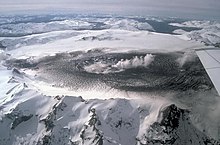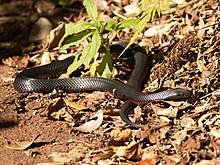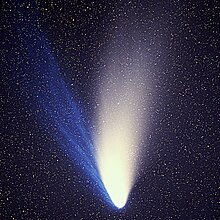Portal:Science
Science portal

Science is a systematic discipline that builds and organises knowledge in the form of testable hypotheses and predictions about the universe. Modern science is typically divided into two or three major branches: the natural sciences (e.g., physics, chemistry, and biology), which study the physical world; and the behavioural sciences (e.g., economics, psychology, and sociology), which study individuals and societies. The formal sciences (e.g., logic, mathematics, and theoretical computer science), which study formal systems governed by axioms and rules, are sometimes described as being sciences as well; however, they are often regarded as a separate field because they rely on deductive reasoning instead of the scientific method or empirical evidence as their main methodology. Applied sciences are disciplines that use scientific knowledge for practical purposes, such as engineering and medicine. (Full article...)
Featured article -
Comet Hale–Bopp (formally designated C/1995 O1) is a long-period comet that was one of the most widely observed of the 20th century and one of the brightest seen for many decades. (Full article...)

The Pacific blue-eye (Pseudomugil signifer) is a species of fish in the subfamily Pseudomugilinae native to eastern Australia. Described by Austrian naturalist Rudolf Kner in 1866, it comprises two subspecies that have been regarded as separate species in the past and may be once again with further study. It is a common fish of rivers and estuaries along the eastern seaboard from Cape York in North Queensland to southern New South Wales, the Burdekin Gap in central-north Queensland dividing the ranges of the two subspecies. (Full article...)
The secretarybird or secretary bird (Sagittarius serpentarius) is a large bird of prey that is endemic to Africa. It is mostly terrestrial, spending most of its time on the ground, and is usually found in the open grasslands and savanna of the sub-Saharan region. John Frederick Miller described the species in 1779. A member of the order Accipitriformes, which also includes many other diurnal birds of prey such as eagles, hawks, kites, vultures, and harriers, it is placed in its own family, Sagittariidae. (Full article...)
Maya stelae (singular stela) are monuments that were fashioned by the Maya civilization of ancient Mesoamerica. They consist of tall, sculpted stone shafts and are often associated with low circular stones referred to as altars, although their actual function is uncertain. Many stelae were sculpted in low relief, although plain monuments are found throughout the Maya region. The sculpting of these monuments spread throughout the Maya area during the Classic Period (250–900 AD), and these pairings of sculpted stelae and circular altars are considered a hallmark of Classic Maya civilization. The earliest dated stela to have been found in situ in the Maya lowlands was recovered from the great city of Tikal in Guatemala. During the Classic Period almost every Maya kingdom in the southern lowlands raised stelae in its ceremonial centre. (Full article...)
Carnaby's black cockatoo (Zanda latirostris), also known as the short-billed black cockatoo, is a large black cockatoo endemic to southwest Australia. It was described in 1948 by naturalist Ivan Carnaby. Measuring 53–58 cm (21–23 in) in length, it has a short crest on the top of its head. Its plumage is mostly greyish black, and it has prominent white cheek patches and a white tail band. The body feathers are edged with white giving a scalloped appearance. Adult males have a dark grey beak and pink eye-rings. Adult females have a bone-coloured beak, grey eye-rings and ear patches that are paler than those of the males. (Full article...)

"Well he would, wouldn't he?", occasionally referenced as Mandy Rice-Davies Applies (shortened to MRDA), is a British political phrase and aphorism that is commonly used as a retort to a self-interested denial. (Full article...)
Featured pictures
Vital articles
Economics (/ˌɛkəˈnɒmɪks, ˌiːkə-/) is a social science that studies the production, distribution, and consumption of goods and services. (Full article...)
Did you know...
- ... that examples of artificial planets in science fiction include Riverworld, the Well World, and the Death Star?
- ... that the psychological inner space genre was a rebellion against the traditional focus of science fiction on literal outer space?
- ... that E. F. Bleiler conducted research for Science-Fiction: The Gernsback Years by reading all 1,835 stories published in science fiction magazines between 1926 and 1936?
- ... that Cambodia's first science-fiction film, Karmalink, combines Buddhist concepts of karma with themes of artificial intelligence?
- ... that the Alexander McQueen collection Neptune drew negative reviews comparing the clothing to 1980s science fiction, Xena, and Wonder Woman?
- ... that Charles Leslie Richardson was ordered to "make science fashionable in the army"?
Get involved
| This portal needs to be updated. Please help update this portal to reflect recent events or newly available information. Relevant discussion may be found on the talk page. |

|

|
Science News
- 16 January 2025 – 2025 in spaceflight
- Blue Origin launches its New Glenn rocket for the first time from Cape Canaveral Space Force Station in Florida, United States. The rocket's second stage, carrying a prototype Blue Ring spacecraft, successfully reaches a geocentric orbit, but its reusable first stage is lost during landing. (CNN)
- The twin satellites SDX01 and SDX02 of the SpaDeX mission, launched in December by the Indian Space Research Organisation, successfully conduct India's first spacecraft docking, with India becoming the fourth country to successfully dock a spacecraft after the United States, Russia, and China. (BBC News)
- SpaceX launches its seventh test flight of the Starship launch vehicle, with an improved second stage, at Starbase in Texas, United States. The first stage is successfully caught by the launch tower but the second stage breaks up shortly before engine shutdown. (CNBC)
- 2 January 2025 – 2025 in paleontology, Dinosaur finds in the United Kingdom
- The largest site of dinosaur footprints of the Cetiosaurus and Megalosaurus dating back to the Middle Jurassic Bathonian stage 166 million years ago is discovered at a quarry in Oxfordshire, England, United Kingdom. (BBC News)
- 25 December 2024 – 2024 in archosaur paleontology
- Scientists confirm the discovery of the Alpkarakush kyrgyzicus dinosaur species in Kyrgyzstan, the first theropod from the Jurassic period to be discovered in Central Asia. (Tempo)
- 23 December 2024 –
- A team of scientists at the North-Eastern Federal University in Sakha Republic, Russia, unveil the highly preserved remains of a 50,000-year-old female juvenile woolly mammoth named Yana. The researchers say Yana was roughly about one-year-old when she died, likely from drowning, and was discovered in the Batagaika crater by locals. (BBC News)
Related portals
Top 10 WikiProject Science Popular articles of the month -
Categories -





























































